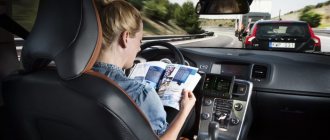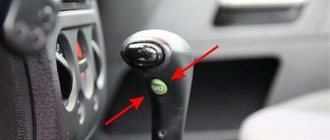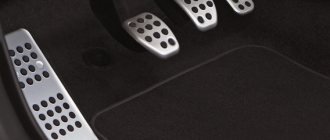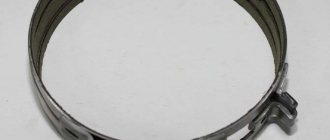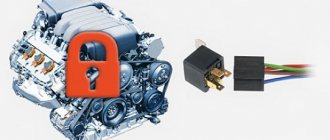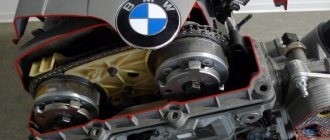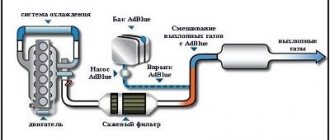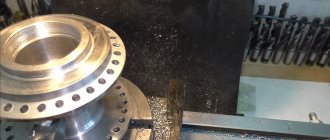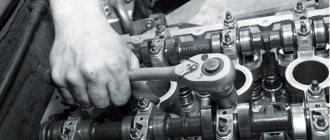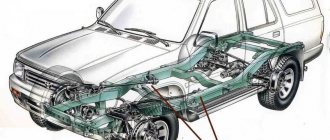As you know, the main purpose of the transmission is to transmit torque from the engine to the drive wheels. At the same time, the transmission not only transmits, but also converts torque. Most drivers know that a manual transmission has low and high gears. Conventionally, 1,2 and 3 can be considered reduced, 4 is considered to be direct transmission, while 5 and 6 are increased.
Let us immediately note that in relation to SUVs, trucks and various types of equipment, such a conditional division is not enough. The fact is that the gearboxes on such cars have not only “low” and “high” gears, but also so-called downshifts. Next, we'll look at why downshifting is needed, what it is and how it works, and how to use downshifting.
Why is low gear needed?
So, let's look at the example of an SUV. In this case, a reduction gear can significantly increase the vehicle's cross-country ability. In simple words, the presence of a downshift allows such a car to drive where cars with a conventional gearbox are not able to overcome the obstacle and continue driving.
To make it clearer, you need to pay attention to the following. Typically, a power unit produces maximum power at a certain number of revolutions. Also, at certain speeds, different from the speed of maximum power, the maximum torque is achieved, which is transmitted through the transmission to the drive wheels.
So, usually gearboxes are designed so that the engine delivers maximum torque and power fairly evenly at different speeds. The first gear allows you to move away, and in this gear the “emphasis” is on maximum torque, while in the 5th gear the car can move at high speed at maximum power speed.
The result is that when you press the gas pedal, the car “buries” its wheels in snow or mud, slips and cannot continue moving. If you switch to second speed or higher, the engine will simply stall, since it does not have enough revolutions and power to overcome the difficult section.
It turns out that in a situation where you need high engine power (high speeds), but also need a smooth ride at low speeds and low wheel speeds, a conventional gearbox is powerless. It is with these features in mind that SUVs receive a transfer case with a low gear.
So, active low gear has a high gear ratio. This allows you to reduce the wheel speed and at the same time spin the engine to maximum power speed. As a result, the car is able to move at low speeds at maximum power speeds. This feature is indispensable on off-road terrain, when driving uphill, on steep descents, etc.
Purpose of double squeeze
Mechanisms such as synchronizers facilitate the process of gear shifting, making it smooth. At the same time, wear is reduced and the specific grinding noise characteristic of older models is also eliminated. If there are no synchronizers or they are broken, you cannot do without double squeezing.
So why is it really needed? The need is due to the equalization of engine speed by gears and shafts. Otherwise, these parts may jam at best. In practice, this happens as follows: moving at first speed, the engine speed is increased to three thousand revolutions. To switch to second, you need to release the gas, squeeze the clutch, go to neutral. Then wait until the speed drops and press the clutch again, switch to second. In this way, the shafts are equalized without damaging the gearbox. Then you can move on calmly.
In the case of re-gassing, the process is a reverse action. This implies reducing the gear without putting the gearbox to sleep. If you need to turn on the road, but it is impossible to do this in fourth gear, you must slow down and lower the gear. Otherwise, there is a risk of stalling. You can smoothly release the gas by squeezing the clutch and move to neutral. The next action will be to gain momentum. To do this, you will have to activate the gas pedal, in other words, make a shift. That's it, after that we managed to increase the speed. Synchronization with the shaft has occurred. You can now downshift and continue driving.
It is recommended to adhere to the throttle pause at neutral during the process. The main thing here is to catch the right clutch moment in time to prevent the car from stopping. Skills come with experience, of course. Therefore, there are no special skills or secrets here.
The question arises: why is this necessary when modern cars are equipped with synchronizers? If you remember that often the road is not perfectly smooth, there are always some obstacles.
Therefore, synchronizers may fail on the first bump or climb. This is where re-gassing comes to the rescue. For example, when going up, you realize that this transmission cannot pull you through. There are simply not enough revolutions, the throttle is overloaded. This allows you to switch to a lower gear without losing the necessary inertia.
Downshift and usage features
Let's start with the fact that a low (downshift) gear can be present in both a manual and automatic transmission. In this case, the best option is considered to be a solution with a separate type of transfer case. Unfortunately, today a separate transfer case is usually installed on expensive full-fledged SUVs, since such a box increases weight and leads to an overall increase in the cost of the car. If there is no separate transfer case (with its own lever), then the downshift must be activated with a separate button.
You also need to remember that low gear on different cars has a certain gear ratio. The higher this number is, the better the car “rakes” on poor surfaces under load.
It should also be taken into account that the presence of a lower gear imposes certain obligations on the driver. In other words, you need to be able to use this solution, since some rash actions and gross mistakes can disable the checkpoint. Let's look at, if the car has a low gear, how to use such a gear correctly.
- First of all, downshifting should only be done when the car is not moving. For example, with a manual transmission, you first need to lock the car with the brake pedal, then depress the clutch and move the transfer lever to engage a gear (for example, first low). Modern cars may also have a separate electronic switch button.
- Driving in low gear on hard surfaces is prohibited. The fact is that in this case the transmission is subjected to heavy loads, the engine also works under heavy load and wears out more. It turns out that on unpaved surfaces or snow you can climb or descend at a low speed at a reduced speed, but you can simply drive with the reduction gear engaged on flat asphalt or dirt road is strongly discouraged.
- In order for the effect of a downshift to be most pronounced, you need to start at high speeds, spinning the engine up to the speed of maximum torque/power. In parallel, on a car with a manual transmission, you need to be able to operate the clutch pedal so as not to burn out the clutch itself. Even taking into account the fact that the load on the clutch after engaging the “lower gear” is noticeably reduced compared to the usual first or second gear, the clutch can still be “scorched” or even damaged.
This is possible if the driver presses the gas pedal too actively and keeps the internal combustion engine in the maximum power speed range while simultaneously operating the clutch pedal intensively.
Switching gears while moving
In the recommendations for operating cars, there is the following point: “Switching the manual transmission must be done at certain speeds and tachometer readings . This increases the service life of the gearbox and engine, improves driving efficiency and protects the environment.
It is advised to change gears at 2-3 thousand revolutions according to the tachometer. If it is not there, then we focus on speed. Experienced drivers say that it is better to shift at the beginning of the climb and stay in a lower gear until the hill ends. If you switch while driving up a hill, you can lose the dynamics of the movement, the engine speed will drop and it will be more difficult for the engine to overcome the obstacle. This leads to increased wear of internal combustion engine parts and increased fuel consumption.
There are gearboxes with a large number of speeds. They are needed more to save fuel and reduce emissions of harmful substances.
Consider the stages of switching in motion
- Let's eat. Release the gas pedal and simultaneously press the clutch. The pressure should be smooth, but not slow
- We shift the gearbox to neutral and then to the desired gear. Switching on mechanics occurs only through the neutral position. Experts recommend taking a short pause when changing from one gear to another. This will save the box. They advise you to count to two. That is, the lever is in one position - we count “One” and move it to neutral. We count “Two” - turn on the desired gear
- Smoothly release the clutch pedal, without sudden movements of the foot. Having brought the clutch to the point of setting, squeeze approximately halfway. If you release the clutch pedal sharply, the car may jerk or it will “peck” its nose, and your face will hit the steering wheel. Lightly press the gas.
- Keep the gas pedal slightly pressed so that the engine does not howl, because the clutch is in the middle position
- Smoothly release the clutch completely.
- We take our foot off the pedal. It's better to move her to the side so she can rest
Advice for beginners and more. Never keep your foot on the clutch pedal unless you want to change gears. Take this as a rule or develop this habit in yourself - switch, move your leg to the side .
If you do not adhere to this rule, you can quickly destroy the gearbox release bearing. Even when the pedal is slightly pressed, the bearing begins to work. During long trips, its resource is sharply reduced, because it is constantly pressed against the plates of the gearbox basket, and it needs to rest. It is activated only when changing gears; the rest of the time it should be inactive.
Common Mistakes
Let's consider the erroneous actions of beginners or those who switched from automatic to manual. They can lead to premature transmission failure.
- Not changing gears in a timely manner. They do not pay attention to the speed of the car and engine speed
- Slowly move the manual transmission lever. As mentioned above, you need to switch clearly and relatively quickly, on the count “2”. If this is done smoothly, the car will begin to brake with the engine. While you switch, you will need to accelerate again to keep up with city traffic.
- Smoothly pressing the clutch pedal leads to a decrease in driving speed. At the moment of changing gear, you release the gas and begin to press the clutch. At this moment, the box is in rigid coupling with the motor. Since the accelerator pedal is not pressed, fuel is not supplied, the engine begins to slow down the car. Therefore, we press quickly until we lose speed, switch gears and smoothly release the pedal.
- They release the clutch pedal sharply. This will cause the machine to jerk and jerk. As a result, you can bump your nose into the steering wheel and damage the gearbox elements.
What's the result?
As you can see, low gearing in a car that is positioned as an SUV is a necessity. In this case, the efficiency of the reduction gear itself will depend on the gear ratio.
The reduction gear makes the SUV a full-fledged rogue, capable of overcoming obstacles that other cars would not be able to overcome. A low gear in the transmission, when engaged, makes it possible to spin the wheels with fewer revolutions at standard engine speeds. What is a reduction gear and why is it needed in a real jeep - more on that below.
If you want the car to buck, turn it down
Automobile. Free car transfer
With downshifts the situation is somewhat more complicated than with upshifts. If you are a novice driver and this is not obvious to you, do the following: accelerate to 50 km/h in 3rd gear, engage 2nd gear and quickly release the clutch pedal as usual. As a result, the tachometer needle will jump up sharply, and the car will jerk violently. Try it! Happened?
This will always happen when moving from a higher gear to a lower gear, only the intensity of the jerk will be different depending on the speed and gear. Why does the jerk occur? As the sharply “bouncing” tachometer needle shows us, when the gear is lowered, the engine speed increases. If, when switching from II to III gear, the needle drops from 3500 to 2500 rpm, then when switching from III to II, on the contrary, it jumps from 2500 to 3500. This means that by including a lower gear, we forcibly accelerate the engine to higher revs. Since the rotating parts of the engine are heavy and inert, they resist spinning up, which is what results in the machine jerking. It turns out that the jerk is like a protest of the motor
Low gear - operating principle
The low gear is part of the transmission and is mounted directly into the transfer case. It is there that the torque from the engine is distributed on the axis of the drive axles of the SUV.
Engines develop their full power at a given number of revolutions, and all torque is transmitted through the transmission to the drive wheels (each unit has its own speed threshold, at which it produces maximum torque). An ordinary gearbox is made so that the engine transmits all the power correctly and evenly at various speeds at which the car moves. For example, in first gear you can move away at a speed slightly higher than standard idle (for example, about 1000), and in fifth gear you can reach a high speed of several thousand. As a rule, engines develop their maximum power at just a few thousand revolutions. For some engines it is 2.5-3 thousand, for another it is under 6 thousand. It will not be possible to drive in first gear at such high speeds, so the engine power when driving will be far from maximum.
Transfer case
Consequently, it is no longer possible to drive onto a high obstacle - the engine will stall or the wheels will slip. The same is true when driving through mud, snow and other similar obstacles. In other situations, high engine power is required, but leisurely and careful driving is required - for example, on a rocky road with a cliff.
This is where downshifting comes in handy. And not only in these, but also in many others. What happens when you turn it on? Active low gear has a sufficiently high gear ratio, which allows the wheel speed to be reduced at maximum engine power. So it turns out that at low speeds the car operates at maximum power, which, with the proper approach, provides a huge advantage off-road, when climbing a steep slope and in other driving conditions.
When is maximum power needed?
A low gear is very helpful when it is necessary to use all the capabilities of the car to the maximum, for example, when driving on mountain roads and passes, and when it is necessary to drag a heavy load uphill. Under these conditions, the transmission and engine of the SUV are under maximum load, and without a reduction gear the car simply would not be able to drive in such places. In addition, slipping on a hill is very dangerous, since the car can fall down the slope without being able to somehow control it.
Source
Low gear - functionality features
Low gear can be used both on SUVs with a manual transmission and with an automatic one. Not all cars, especially new ones, have the classic solution with a separate transfer case. If the car does not have a transfer case, then the reduced gearbox must be activated using a special lever or button (in modern cars). Why don't they put a transfer case in seemingly full-fledged SUVs? It makes the car heavier and more expensive. In search of effective, cost-effective solutions, many jeeps are not equipped with a transfer case. Even in older models it is sometimes missing. Take the LUAZ as an example - it has a front-wheel drive, the rear is connected directly through the gearbox. But the car drives at a reduced speed only forward, which in many situations is a serious disadvantage.
Low gear has a specific gear ratio. The higher it is, the more efficiently the car will row even at low speeds. For example, on a UAZ, the first gear comes with a number from 3.78 to 4.155 (common brands of gearboxes such as Ulyanovsk or Dymos). Together with the transfer case, which has a reduction value of 1.95, the whole number will be approximately 8.1. In order to increase this parameter, special, non-standard gears with gear ratios, for example, 2.89 or 3.80, can be installed in the transfer case. When multiplied, this will give us a total gear ratio of 15.8. This means the jeep will be able to overcome even more severe obstacles, and also spin larger, non-standard wheels more freely in the mud.
In a word, a low gear in an off-road vehicle is very necessary, and its cross-country ability depends on what it is. Of course, you need to be able to use it and not foolishly break the transmission or even the engine (which also happens).
What are digital nomads like?
A prerequisite for digital nomadism is having a job that can be done from anywhere in the world with a stable and fast Internet connection. A digital nomad can be officially employed by one company, or be a freelancer with many clients, or even have his own business.
Our people go to the bakery by taxi
Banks and experts note changes in consumer standards
The main thing is that digital nomads are people who use technology to make a living while traveling. At the same time, they can either change host countries one after another, or lay low for some time in a place they like, if the visa regime allows.
Low gear - how to use
Downshifting occurs when the car is stationary. The corresponding lever is moved to the desired position (usually the first downshift position) when the clutch is depressed. In newer cars, the downshift can be activated electronically using a special button.
You cannot drive on hard surfaces in low gear. The transmission receives a heavy load and may not be able to withstand it. The engine is also unnecessarily loaded and problems may begin. We are not talking about climbing a hill on dirt or moving on a more or less solid snow surface, but you cannot drive in low gear on simple dirt roads or on asphalt roads.
In order to achieve the most beneficial effect from a lower gear, it is advisable to start at high speeds (at those at which the engine operates at its maximum and produces optimal torque). At the same time, you need to be careful not to burn the clutch. Although the load on it is reduced by about half, due to inexperience it can be damaged (if you try to release it abruptly, cranking up the engine to high speeds).
Forced locking of the cross-axle differential on Niva
The VAZ SUV was developed as a car for the village.
At the time, it was said that additional interlocks would complicate the design, making it more expensive and less reliable. In addition, the Niva already has good cross-country ability. This is probably correct. However, in a country where the percentage of paved roads out of the total number is relatively small, we want more. Various small and large enterprises took advantage of this, mastering the production of differentials with forced locking. The following should be noted immediately .
Installing forced-locking mechanisms on the Niva instead of standard differentials significantly increases the load on the axle shafts and transfer case, which can lead to their premature failure.
And, nevertheless, since such a rework is possible, it is necessary to say a few words about it. Currently, the most common differentials are:
- With pneumatic connection;
- With electrical connection;
- Self-locking.
Briefly - the advantages and disadvantages of each of them.
Pneumatic connection.
The wheels are locked from inside the car using compressed air. In this case, a silicone hose is laid to the car axle. The device is quite reliable, but requires additional expensive equipment. A set of hoses, a compressor and a receiver are sometimes more expensive than the differential itself.
Electrical connection
The differential gear is locked by a cam mechanism, which is activated by electromagnets. The device is reliable and does not require maintenance. The downside is the high current consumption, which places additional demands on electrical equipment.
Self-locking mechanisms
Their operating principles are different. Some are blocked at the slightest slip, others when the load on the wheels increases. However, regardless of the design, they do not require human intervention, and therefore are popular among SUV owners. But their main advantage is that they do not have such a rigid locking as all other types, which means they partially remove additional load from the axle shafts.
How not to get stuck in the snow (in the mud). Tips for beginners
Here, beginners will find the most important answers to the main points that can help them better use all the capabilities of their all-wheel drive vehicle.
Mode "2H" is used for normal road traffic. Driven by two wheels, usually at the rear, in a high gear range, normal gear ratio, used for everyday driving.
Some vehicles may have full-time 4WD or four-wheel drive, in which case they will not have 2H single-wheel drive.
The 4H all-wheel drive mode is used for normal driving speeds (not low speeds) but when you need extra traction.
4H mode is great for driving on dirt roads, roads covered with ice or snow, compacted or frozen sand. Both the front and rear wheels operate in a high gear range, using the same gear ratio as when one of the axles is in 2H mode.
In this case, the front wheels help with traction, making the car more stable on precarious surfaces.
The 4L low range gear is used when you need maximum traction and maximum power: steep grades or inclines; deep rut; deep mud or snow; soft soil, sand or vice versa, rocky, stone surfaces.
The front and rear wheels are driven by low gear, which uses a lower gear ratio. The wheels spin much slower per revolution than in a regular gear, resulting in slower driving speeds but also higher torque that helps you pull up steep climbs or in challenging off-road conditions. A lower gear gives the car better engine braking, which improves downhill handling.
Attention: DO NOT forget to turn off 4L mode after driving through a difficult section
If your 4WD vehicle has manually disengaging drive wheel hubs located in the center of the two front wheel hubs, you will have to engage them if you want to use 4H or 4L 4WD modes. They will lock the hubs and wheels with the front differential output shafts.
Even with 4H or 4L mode engaged, the front axles will not move until the cap is turned to the "closed" position.
Drive wheel hubs with automatic drive shut-off do not require manual intervention. Read the owner's manual for your vehicle.
Good advice
I’ll give you a few more general recommendations, and also touch on the topic of at what speed you should switch if the driver prefers to navigate by the tachometer. This is true for beginners who simply do not yet know how to rely on the sound of the engine.
- Always try to keep your foot on the designated resting area. Do not hold it directly over the pedal;
- Adjust the position of the chair relative to the box to suit you. When shifting, you should not reach for the lever;
- When performing actions with the box, be sure to move your left hand to the center of the steering wheel, to its top point. This will allow, if necessary, to perform an emergency maneuver with only one hand;
- Initially, it is recommended to switch using the tachometer;
- If you have a diesel engine, then the transition from gear to gear is carried out at 1500-2000 rpm;
- For gasoline engines, the current range on the tachometer is 2000-2500 rpm.
These are really important recommendations that should be strictly followed.
Everything comes with experience and practice. But competent work with a manual transmission allows you to significantly save fuel, preserve the integrity of the transmission components, engine and pedal assembly, and also use every horsepower to the maximum.
What secrets of manual shifting do you know? Share in the comments.
Thanks to everyone who reads us! Subscribe, leave reviews, ask questions!
( 18 ratings, average: 4.61 out of 5)
In the last article I wrote how to shift up gears correctly. It's time to move on and discuss downshifts. Go…
Do I need to change tire pressure in winter?
The first snow has already fallen in the Moscow region, more will follow, so novice jeepers will probably be tormented by the question, what to do with tire pressure? To reduce it or not.
The answer is:
You don't need to do anything. Leave the pressure the same, the snow chains are more important here. Therefore, if you go winter fishing or for some business to a snowy field, be sure to take chains with you.
The next time you find yourself far from the road, remember this reminder. By engaging all-wheel drive in time, you have less chance of getting stuck and will emerge victorious from the mud or deep snow.
Types of gearboxes have certain advantages and disadvantages. In the case of an automatic, it is more suitable for driving on city roads where moderate speed is required. Speaking of mechanics, there is good efficiency, thanks to which the driver feels his car to the fullest. It happens that when overcoming hills, it is difficult to choose the optimal gear. If you switch to third, the engine does not have enough power. When the second one is turned on, there is excessive thrust, leading to excessive engine consumption. This is where you can’t do without a lower gear.
The automatic transmission is gaining recognition not only among novice drivers, but also among experienced motorists. The combination of ease of use and reliability is all about automatic transmission. The century of technological development has left its mark on it, equipping it with a mode with lower gears. Which in turn ensures a comfortable ride on any terrain, especially on difficult roads.
Most modern modifications of automatic transmissions have letter markings indicating such a reduction. It usually looks like it has an "L" on it. Activating this mode makes it possible to switch at the right time, taking into account road conditions. Advanced car models, mostly SUVs, are equipped with automatic transmissions with special functionality that allows the car to adapt to rocks, when driving on sand or snow.
Riding in difficult conditions
No matter what crossover owners fantasize about, their plug-in all-wheel drive is only enough to conquer the lawn near the house. To drive on sand, loose snow, and mud, you need a serious car and the ability to use it. Electronic systems on crossovers will not allow driving on such heavy surfaces - an attempt to force, for example, virgin snow, is guaranteed to end in digging into the snow and wheels slipping in place. The lowering gear is capable of providing constant and high torque to the wheels at low rotation speeds. Thus, the SUV is able to drive without throttle to the floor without slipping or bogging down.
Turn on the "lower"
By starting a low-range gear, a large torque is transmitted to the wheel drive. As a result, difficult roads can be overcome without serious load on the engine.
This mode is not the only one on modern machines. The driver can also select other operating modes. You can save fuel while traveling on highways by switching the gearbox to high-speed operation. We often encounter the problem of traffic jams; in such a situation, it is logical to switch the gearbox to a mode not exceeding first gear. Typically this setting is used when driving at low speeds.
Off-road without reduction
SUV with reduction gear KIA Sorento
In recent years, the trend towards increasing the civility of SUVs and crossovers has acquired a scale that is depressing for experienced jeepers. Real SUVs are chasing comfort, which leads to an increase in their prices, and often to a decrease in cross-country ability and closer proximity to crossovers. Crossovers, in turn, are becoming more and more similar to asphalt machines. There are practically no frame SUVs left. Many people part with downshifts. Following the flagships, other SUVs are also becoming lighter. So the KIA Sorento has remained without a downshift since 2009. What can we say then about crossovers! The Porsche Cayenne S with a 6-speed Tiptronic S transmission has a reduction gear, but since 2010 the Porsche 958 Cayenne has received a new version of Tiptronic with 8 steps, but without a reduction gear. The designers of the Audi Q7 also abandoned downshifts. A general trend is visible, the paradox of which illustrates the “spiral” nature of development. Modern crossovers, or rather that part of them that has some claims to the title of SUV, are simply supplemented with 1-2 steps in the gearbox. The transmission of a quite “budget” Renault Duster is designed in such a way that it is better to start on the asphalt in second gear, and leave first for driving on questionable roads. Actually, their designers repeat the line of thought of the LuAZ developers. Only with other tasks. The buyer is inclined to pay more for comfort than for the capabilities of the car. This is probably a real change in the needs of the majority of motorists. And for true connoisseurs of free movement in different directions, there remain the indestructible simple cars of the last century and the off-road supercars of the new century.
https://youtube.com/watch?v=koKbdJUwEZ0
Winter driving on automatic
Installed modern car systems allow you to move from a place after a long period of inactivity in severe frosts. But this doesn't mean you need to rush. It would be better if you let the engine work without straining. Thus, when the oil mixture dilutes, the lubrication system is filled. As a result, the piston element will heat up. The manipulations will take no more than three minutes.
After starting the engine and pressing the brake pedal, you should move the automatic transmission to position D. This mode lasts about thirty seconds, then switches to reverse (R). Then you will have to wait a little, repeating these steps twice. The driver should lightly depress the gas pedal, initially holding the handbrake.
Proper movement on a snowy road requires maximum smoothness, without sudden acceleration and braking. A sufficient distance must be maintained between your car and the person driving in front. Don’t forget, when driving along a snowy road where there are often patches of ice, the activation of ABS will ensure that the vehicle moves in a straight line. At the same time, the braking distance will increase.
Causes of automatic transmission problems and how to fix them
Hi all! Please tell me what happened to my automatic transmission in the Toyota Istima Emina Diesel 2.2 Turbo. Everything was okay, when it started knocking at idle in the donut area. I took it apart and the fastening of the donut disk broke. I set it up and it doesn't go forward or backward. If you accelerate at 3000-3800 rpm, it will go forward until you let off the gas, but it will go backwards. I am waiting!
Hello. I have a Toyota Previa 2007, after replacing the left upper airbag, a terrible grinding noise appeared when driving in reverse. There is no grinding noise at idle speed, but it appears when the speed increases. As a result, I changed all the pillows, but the grinding noise did not go away. What else could it be?
Extending the life of automation
First of all, the performance potential of the automatic transmission is determined by careful operation. An important factor that prolongs the durability of the mechanism is timely and high-quality maintenance.
The duration of a comfortable ride on an automatic transmission will be longer if you constantly monitor the oil level in the box. Using a dipstick from the engine will help sort this out. The main thing is to prevent leaks by changing the oil and filter. It is advisable to do this every 40–60 thousand km. Also, do not save money; it is better to use the original product.
In terms of operation, automation is many times more complex than mechanics. Moreover, such a transmission is more suitable for traveling around a metropolis. There’s just a nuance: the machine doesn’t like high overloads. Do not torture the system until it warms up. This is especially true in winter.
Once you change from a manual to an automatic, you can confidently say: you won’t change back.
Experiment 13
Problem 1
Build underdrive and overdrive gears with ratios of 1:5 and 3:1.
Problem 2
Assemble the gear train on both sides of the beam. Try changing the mechanism using other gears.
Problem 3
Build a capture model. Place the worm between the gears
Problem 4
Build a helicopter model using gears in different planes.
Clutch when shifting gears
You described throttling when lowering, also with double squeezing. And I described upshifting. This is not nonsense, but quite a method of switching up: https://www.rallyfan.ru/driving/faq/gear.php see “Shifting from the bottom up” Although the terms “under-gas” and “re-gas” are still used more when describing downshifting rather than upshifting. Here's a good link about the downgrade: https://www.rallyfan.ru/driving/faq/19.php
There is no speedometer, and you won’t need a tachometer with experience either - you’ll switch by the sound of the engine. you just hold the gas pedal so that the speed does not drop to idle and does not rise too high - they are individual for each car - and when the clutch is engaged, the car continues to drive without “nodding”
